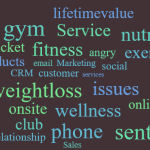For more 2000 Census trends, check out Who We Are Now: The Changing Face of America in the 21st Century, by Sam Roberts.
Our view: Most U.S. communities, regardless of size, are in a state of demographic transition. Based on our analysis, the core customer base for many wellness businesses – 18 to 34 year-olds – is beginning to dwindle unless you’re in an area with strong ethnic growth. This is one reason that traditional health clubs in aging communities find it increasingly difficult to win new customers.
However, this trend offers a golden opportunity to focus on wellness and lifestyle activity. And, if you’re in a community experiencing rapid growth in particular ethnic segments, the time is also ripe to begin focusing on their needs. For example, partnering with a local grocery that caters to Hispanic customers may offer new business opportunities if you operate a wellness business in the Southwest.
Action: You can’t predict what’s happening in your community simply by looking at the US population as a whole. We tend to overlook gradual change, yet it can radically reshape a neighborhood in just a few years. For example, a three-block stretch in Dallas that now has a successful two-story yoga studio and fitness products business was dominated by rundown storefronts just a couple of years ago.
Educate yourself on your market area in three steps:
1. Assess your current market
Gather data from your library and Chamber of Commerce, local business publications, and free US census data available online at http://www.census.gov. Gather clues about what’s changing in your community. Do you see more assisted living complexes or elementary schools? More mini-malls or currency exchanges? What other businesses are near yours? What languages are people speaking? Do you see many teenagers? Pedestrians? Think back a few years – how has the neighborhood changed? Then consider the implications for your business… how and what you sell, your day-to-day operations, even your hiring and customer payment practices.
2. Analyze your prospects
List the kinds of prospects your business attracts. List the kinds of prospects who turn into paying customers. If you’re a storefront operator, tally demographic data (general age, ethnicity, gender, etc.) for the people that walk past your store every day. How does that compare to your current customer base? Perhaps your existing customers are still white males aged 18-34, but for every customer you win, you lose 3 prospects in their 40s who don’t think your business is for them. If so, ask yourself whether the focus of your business will be sustainable over the next few years.
3. Analyze your current customers
Again, start by asking yourself what’s changed over the last 2-3 years. Perhaps you get walk-in business from office workers on lunch breaks now, when five years ago most of your sales traffic occurred on weekends. Compare your current customers to the demographic tally of passersby that you did in Step 2. Identify the differences. Does this suggest anything about missed opportunities? Look at the customers you’ve lost as well. That also offers important clues about how your community may be changing and what that means for your business.
Once you’re up to speed on your market, prospects, and customers, step back and look at the products and services you currently offer and how you do business. Adapt your business to your community. For example, we’ve counseled a retailer to offer extended evening and weekend hours, since the business is located in a strip shopping center that contains other businesses open during those hours. Take a look at your current sales and marketing efforts, any programs you offer, and your employee training. Make sure that you’ve designed your business around the unique opportunities your community offers.


